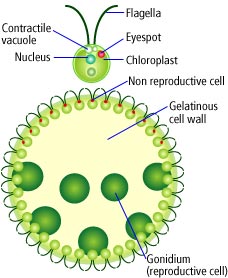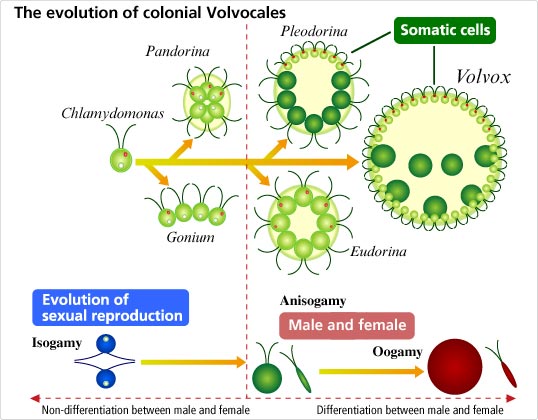The English word “woman” is derived from the word “wifman,” which was formed by adding the word “wife” onto the word “man.” However, it has been discovered that at the genetic level, it is the female organism that becomes the male organism, by means of the “male” gene. The origins of the two sexes (male and female) are now becoming clear.
The Creation of Adam

“The Creation of Adam” by Michelangelo. God imparts life to Adam through the tip of his finger.
© 2009 Bridgeman Art Library/PPS
The Sistine Chapel in the Vatican is renowned as the venue for the conclave that elects each new Pope. The walls and the ceiling are covered with Michelangelo’s frescoes, of which the ceiling painting “The Creation of Adam” is particularly famous.
It is said that God created the Universe in seven days and that Adam was created on the sixth day. However, because Adam appeared to be lonely, God created Eve from one of Adam’s ribs. This was the birth of Adam and Eve, according to the Old Testament.
However, it is only very recently that we have discovered how males and females actually acquire their sex. This was revealed through the study of small organisms called algae.
Tumbling fast and furiously
Volvox
© EUGLENA Co. Hotta
Volvox swimming toward light (5x speed)
© EUGLENA Co. Hotta
Volvox is a small round algae that can be found in lakes and rice paddies. In Latin, “volvox” means something that is tumbling fast and furiously. Volvox consists of small green cells crammed into a transparent gelatinous sphere no more than 1 mm in diameter. At first glance, these tiny cells appear to be individual organisms. However, because they cannot survive independently, it can be said that Volvox is a single life form that consists of a collection of cells.
Volvox is phototactic by nature, meaning that it swims toward light. Because it performs photosynthesis, its ability to head in the direction of light is necessary for its survival. But how is it possible that such a small and primitive organism can move toward light?
Volvox features an array of individual light-sensitive sensors attached to individual cells on its surface that are known as “eyespots.” On each cell there are also two hairs known as “flagella.” It is known that when light strikes an eyespot, the flagella on that cell stop moving. In other words, when the flagella on the area struck by light stop moving, Volvox as a whole starts to move toward the light.

Volvox body
This organism was observed as early as 1700 by van Leeuwenhoek, who is famous for the development of the microscope. In recent years, it has been the subject of great attention, because there is a number of species of Volvox and its relatives (colonial Volvocales), including some in which there are no male and female sexes and some in which there are. This makes it a very fitting subject in the study of the origin of the two different sexes.
Before the division into male and female
Almost all plants and living creatures are divided into two clearly defined sexes—male and female. Consequently, most people would expect that the very start of life on Earth began with two distinct sexes. In fact, the first living organisms were almost identical in every way.
One species related to the Volvox—Chlamydomonas—has two gametes that join together and are of the same shape. The two gametes are indistinguishable from one another and therefore it is impossible to distinguish between male and female. Reproducing in this way—with two gametes of the same shape—is known as isogamy.
In contrast, Pleodorina, more evolved than Chlamydomonas, is a single organism consisting of a collection of cells (see diagram below). Pleodorina’s male gamete (sperm) and female gamete (egg) differ in shape. This is known as anisogamy—the opposite of isogamy. Male Pleodorina produces sperm packets, which it squeezes out of its round, gelatinous body. The sperm enters the body of the female and this leads to fertilization of the female’s reproductive cells.
The evolution of the male gamete into sperm and of the female gamete into an egg is believed to have been for the purpose of ensuring the birth of the next generation. In other words, the female gamete became an egg in order to ensure the provision of nourishment, while the male gamete—the sperm—acquired mobility, since the egg is large and immobile.

The evolution of species related to Volvox
Single cell organisms like Chlamydomonas collected together and evolved into Volvox.

Reference: Pleodorina, a species related to Volvox. Large reproductive cells able to produce offspring. The sperm produced by the male Pleodorina enters the female Pleodorina and fertilizes it.
It is believed that Volvox evolved from Chlamydomonas via Pleodorina. However, how did the male and female diverge from one another in the first place before coming to assume their respective roles?
Species related to Volvox range from Chlamydomonas, in which male and female cannot be differentiated, and Pleodorina, in which male and female are distinguishable. In short, closely related organisms with similar genetic configurations are suitable subjects in the study of the differentiation between male and female. If we study the differences between organisms in which male and female have the same appearance and organisms in which the male and female are clearly different, it should be possible to discover which genes determine male and female. One researcher pursued this very topic—Hisayoshi Nozaki, an associate professor at the Graduate School of Science, University of Tokyo.
The chivalrous gene
Where are the genes that determine male and female? Seemingly basic research to answer this question took off with the 2006 discovery of the male gene otokogi. The word “otokogi” (chivalry) denotes an inclination towards helping the weak. Professor Nozaki, who discovered and named this gene, retained deep and abiding memories of a University of Tokyo Komaba festival poster that was produced in 1968—at the height of the student riots. The pattern on the poster was the university’s logo in the form of a tattoo on a man’s back, in imitation of contemporary gangster movies about chivalry. Inspired by this, he named the male gene discovered at the same university “otokogi.”
The otokogi gene was successfully extracted from Pleodorina. Using a new species of Pleodorina that Professor Nozaki and his team had discovered independently, they manufactured large amounts of male Pleodorina and identified the chromosomes that determine maleness. This gene was known to operate within the nucleus of Pleodorina sperm and to be characteristic of maleness. This represented the discovery of the gene that undoubtedly determines the maleness of an organism.
Incidentally, in the case of isogamous Chlamydomonas, with its identically shaped gametes, one is, for descriptive purposes, termed the “plus” and the other, which joins with the plus gamete to produce offspring, is termed the “minus.” Later, the sex-determining gene MID (minus dominance), which is only present in the latter gamete, was discovered. However, it is not known which of the two (the plus or minus) evolves into the male and which into the female.
Even before the otokogi gene in Pleodorina was discovered, Professor Nozaki’s team predicted that it would closely resemble the MID gene in Chlamydomonas. This was intuitive in a way that only researchers who had long focused on genes would understand. As expected, the otokogi gene and the MID gene had evolved from a common progenitor. This made it clear that the isogamous minus gamete evolved into a male and the plus gamete into a female.
It had already been discovered that in the case of isogamous Chlamydomonas, a minus gamete with the MID gene removed becomes a plus gamete. However, it is impossible to change a plus gamete to a minus gamete. In other words, the manipulation of genes can change a male (minus) to a female (plus), but not a female to a male. This means that the original sex is female, from which male derives.
Subsequently, in 2008, a German team discovered the female-specific gene, using species related to none other than Volvox. It is anticipated that sex determination will be better understood in the near future.
The process of understanding sex determination has only just begun.
Editorial contributor / Date of article posted
Hisayoshi Nozaki, Associate Professor of Biological Sciences at the Graduate School of Science, University of Tokyo / March 2009

